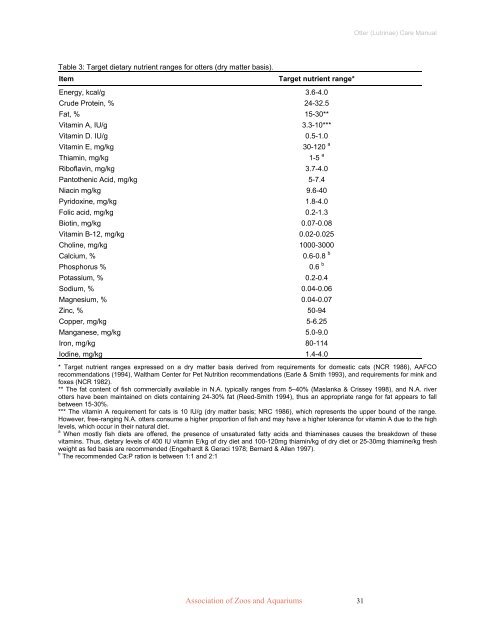Otter (Lutrinae) Care Manual - Association of Zoos and Aquariums
Otter (Lutrinae) Care Manual - Association of Zoos and Aquariums
Otter (Lutrinae) Care Manual - Association of Zoos and Aquariums
Create successful ePaper yourself
Turn your PDF publications into a flip-book with our unique Google optimized e-Paper software.
Table 3: Target dietary nutrient ranges for otters (dry matter basis).<br />
Item Target nutrient range*<br />
Energy, kcal/g 3.6-4.0<br />
Crude Protein, % 24-32.5<br />
Fat, % 15-30**<br />
Vitamin A, IU/g 3.3-10***<br />
Vitamin D. IU/g 0.5-1.0<br />
Vitamin E, mg/kg 30-120 a<br />
Thiamin, mg/kg 1-5 a<br />
Rib<strong>of</strong>lavin, mg/kg 3.7-4.0<br />
Pantothenic Acid, mg/kg 5-7.4<br />
Niacin mg/kg 9.6-40<br />
Pyridoxine, mg/kg 1.8-4.0<br />
Folic acid, mg/kg 0.2-1.3<br />
Biotin, mg/kg 0.07-0.08<br />
Vitamin B-12, mg/kg 0.02-0.025<br />
Choline, mg/kg 1000-3000<br />
Calcium, % 0.6-0.8 b<br />
Phosphorus % 0.6 b<br />
Potassium, % 0.2-0.4<br />
Sodium, % 0.04-0.06<br />
Magnesium, % 0.04-0.07<br />
Zinc, % 50-94<br />
Copper, mg/kg 5-6.25<br />
Manganese, mg/kg 5.0-9.0<br />
Iron, mg/kg 80-114<br />
Iodine, mg/kg 1.4-4.0<br />
<strong>Association</strong> <strong>of</strong> <strong>Zoos</strong> <strong>and</strong> <strong>Aquariums</strong> 31<br />
<strong>Otter</strong> (<strong>Lutrinae</strong>) <strong>Care</strong> <strong>Manual</strong><br />
* Target nutrient ranges expressed on a dry matter basis derived from requirements for domestic cats (NCR 1986), AAFCO<br />
recommendations (1994), Waltham Center for Pet Nutrition recommendations (Earle & Smith 1993), <strong>and</strong> requirements for mink <strong>and</strong><br />
foxes (NCR 1982).<br />
** The fat content <strong>of</strong> fish commercially available in N.A. typically ranges from 5–40% (Maslanka & Crissey 1998), <strong>and</strong> N.A. river<br />
otters have been maintained on diets containing 24-30% fat (Reed-Smith 1994), thus an appropriate range for fat appears to fall<br />
between 15-30%.<br />
*** The vitamin A requirement for cats is 10 IU/g (dry matter basis; NRC 1986), which represents the upper bound <strong>of</strong> the range.<br />
However, free-ranging N.A. otters consume a higher proportion <strong>of</strong> fish <strong>and</strong> may have a higher tolerance for vitamin A due to the high<br />
levels, which occur in their natural diet.<br />
a When mostly fish diets are <strong>of</strong>fered, the presence <strong>of</strong> unsaturated fatty acids <strong>and</strong> thiaminases causes the breakdown <strong>of</strong> these<br />
vitamins. Thus, dietary levels <strong>of</strong> 400 IU vitamin E/kg <strong>of</strong> dry diet <strong>and</strong> 100-120mg thiamin/kg <strong>of</strong> dry diet or 25-30mg thiamine/kg fresh<br />
weight as fed basis are recommended (Engelhardt & Geraci 1978; Bernard & Allen 1997).<br />
b The recommended Ca:P ration is between 1:1 <strong>and</strong> 2:1









